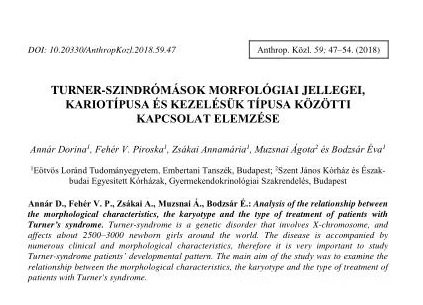Turner-szindrómások morfológiai jellegei, kariotípusa és kezelésük típusa közötti kapcsolat elemzése
Absztrakt
Turner-syndrome is a genetic disorder that involves X-chromosome, and affects about 2500–3000 newborn girls around the world. The disease is accompanied by numerous clinical and morphological characteristics, therefore it is very important to study Turner-syndrome patients’ developmental pattern. The main aim of the study was to examine the relationship between the morphological characteristics, the karyotype and the type of treatment of patients with Turner's syndrome.
Twenty girls and women with Turner-syndrome were studied. The presence or the absence of the morphological characteristics (cubitus valgus, webbed neck, low hairline, four finger crease, short metacarpals and -tarsals, vision problems, low-set ears, spinal malformations, dental malformations) was recorded. The strength of the relationship between the frequency of the examined morphological features and the type of karyotype or treatment was analysed by Fisher’s exact test.
Cubitus valgus, low-set ears, and dental malformations were the most common morphological abnormalities. Webbed neck, four finger crease and short metacarpals and -tarsals showed significant correlation with the karyotype. We didn’t find any correlation of morphological characteristics with the hormone treatment.
Hivatkozások
Annár, D. (2018): Turner-szindrómások testfejlettségi mintázata és testszerkezeti jellegzetességei. MSc szakdolgozat. ELTE Embertani Tanszék, Budapest.
Annár, D., Fehér, V.P., Zsákai, A., Muzsnai, Á., Bodzsár, É. (2018): Turner-szindrómások testfejlettségi mintázata és a testszerkezeti mutatóik alapján elkülönülő alcsoportjaik. Gyermekgyógyászati Továbbképző Szemle, 23(4): 165–170.
Bondy, C.A., Turner Syndrome Consensus Study Group (2007): Care of girls and women with Turner syndrome: a guideline of the Turner Syndrome Study Group. Journal of Clinical Endocrinology & Metabolism, 92(1): 10–25. DOI: https://doi.org/10.1210/jc.2006-1374
Bősze, P., Eiben O.G., Gaál, M., László, J. (1980): Body measurements of patients with streak gonads and their bearing upon the karyotype. Human Genetics, 54: 355–360. DOI: https://doi.org/10.1007/BF00291582
Caprio, S., Boulware, S., Diamond, M., Sherwin, R.S., Carpenter, T.O., Rubin, K., Amiel, S., Press, M., Tamborlane, W.V. (1991): Insulin resistance: An early metabolic defect of turner’s syndrome. Journal of Clinical Endocrinology and Metabolism, 72(4): 832–836. DOI: https://doi.org/10.1210/jcem-72-4-832
Carrel, L., Willard, H.F. (2005): X-inactivation profile reveals extensive variability in X-linked gene expression in females. Nature, 434(7031): 400–404. DOI: https://doi.org/10.1038/nature03479
Chacko, E., Graber, E., Regelmann, M.O., Wallach, E., Costin, G., Rapaport, R. (2012): Update on Turner and Noonan Syndromes. Endocrinology and Metabolism Clinics of North America, 41(4): 713–734. DOI: https://doi.org/10.1016/j.ecl.2012.08.007
Dávid, A., Butz, H., Halász, Z., Török, D., Nyírő, G., Muzsnai, Á., Csákváry V., Luczay A., Sallai Á., Hosszú, É., Felszeghy E., Tar, A., Szántó, Zs., Fekete, Gy.L., Kun, I., Patócs, A., Bertalan, R. (2017): A SHOX géndeletio előfordulása idiopathiás alacsony-növésben. Orvosi Hetilap, 158(34): 1351–1356. DOI: https://doi.org/10.1556/650.2017.30829
Eiben, O., Sándor, Gy., László, J. (1974): Turner-syndomások testalkata. Anthropologiai Közlemények, 18: 41–48.
Falus, A., László, V., Tóth, S., Oberfrank, F., Pap, E., Szalai, Cs. (2014): Genetika és genomika. Egyetemi tankönyv. Medicina, Budapest.
Fernandez‐Garcia, R., Garcia‐Doval, S., Costoya, S., Pasaro, E. (2000): Analysis of sex chromosome aneuploidy in 41 patients with Turner syndrome: a study of ‘hidden’mosaicism. Clinical Genetics, 58(3): 201–208. DOI: https://doi.org/10.1034/j.1399-0004.2000.580307.x
Gonzalez, L., Witchel, S.F. (2012): The patient with Turner syndrome: Puberty and medical management concerns. Fertility and Sterility, 98(4): 780–786. DOI: https://doi.org/10.1016/j.fertnstert.2012.07.1104
György, I., Muzsnai, Á., Péter, F. (2007): A Turner-szindróma hormonpótló kezeléséről. Gyermekgyógyászat, 58(2): 89–93.
Higurashi, M., Iijima, K., Ikeda, Y., Egi, S., Ohzeki, T. (1982): An anthropometric study of cases with Turner syndrome and XYY. Birth Defects, 18(4): 155–167.
Khalid, A.B., Krum, S.A. (2016): Estrogen receptors alpha and beta in bone. Bone, 87: 130–135. DOI: https://doi.org/10.1016/j.bone.2016.03.016
Lerner, U.H. (2006): Bone remodeling in post-menopausal osteoporosis. Journal of Dental Research, 85(7): 584–595. DOI: https://doi.org/10.1177/154405910608500703
Lleo, A., Moroni, L., Caliari, L., Invernizzi, P. (2012): Autoimmunity and Turner’s syndrome. Autoimmunity Reviews, 11(6–7): A538–A543. DOI: https://doi.org/10.1016/j.autrev.2011.11.015
Oláh, É. (2003): A klinikai genetika alapjai. Medicina, Budapest
Ranke, M.B., Saenger, P. (2001): Turner’s syndrome. Lancet, 358(9278): 309–314. DOI: https://doi.org/10.1016/S0140-6736(01)05487-3
Reynaud, K., Cortvrindt, R., Verlinde, F., De Schepper, J., Bourgain, C., Smitz, J. (2004): Number of ovarian follicles in human fetuses with the 45,X karyotype. Fertility and Sterility, 81(4): 1112–1119. DOI: https://doi.org/10.1016/j.fertnstert.2003.12.011
Ságodi, L. (1999): Turner-szindróma. Diganózis-kezelés-gondozás. Medworld, Budapest.
Sybert, V.P., Mccauley, E. (2004): Turner’s Syndrome. New England Journal of Medicine, 351(12): 1227–1238. DOI: https://doi.org/10.1056/NEJMra030360
Trolle, C., Hjerrild, B., Cleman, L., Mortensen, K., Gravholt, C. (2012): Sex hormone replacement in Turner syndrome. Endocrine, 41(2): 200–219. DOI: https://doi.org/10.1007/s12020-011-9569-8
Turner, H.H. (1938): A syndrome of infantilism, congenital webbed neck, and cubitus valgus. Endocrinology, 23(5): 566–574.




